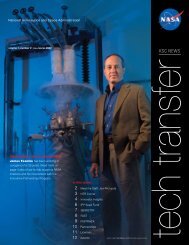2006-2007 - Kennedy Space Center Technology Transfer Office
2006-2007 - Kennedy Space Center Technology Transfer Office
2006-2007 - Kennedy Space Center Technology Transfer Office
- No tags were found...
You also want an ePaper? Increase the reach of your titles
YUMPU automatically turns print PDFs into web optimized ePapers that Google loves.
Surtreat licensed the patent in late <strong>2006</strong>. The company used the technology under a contract withthe U.S. Army to conduct tests on new technologies to preserve Army structures around the world,including those in Okinawa, Japan. Okinawa has a severely corrosive environment because of itshighly corrosive soil and its hot, humid weather. The concrete walls of the warehouse there thatstores supplies for all of the U.S. armed forces in the Pacific Theater have severely deteriorated as aresult of rebar corrosion. If not given proper attention, the rebar will continue to corrode, crackingthe concrete, weakening the walls, and ultimately requiring large-scale structural repair.Surtreat has installed the Liquid Galvanic Coating System® at the U.S. Army NaHa Port, Okinawa,Japan, and NASA is currently awaiting final results of the testing.Scene Analysis SoftwareRoutine analysis of launch video images is critical to <strong>Space</strong> Shuttle operations at KSC. During everylaunch, large amounts of foreign-object debris (FOD) could strike the Shuttle during its ascent.Thus, it is critical to identify and locate FOD in the vicinity of the spacecraft and to measure thespeed and direction of the FOD during the first few minutes of flight.Innovators from ASRC Aerospace developed a Microsoft Windows-compatible program for3-D–scene photogrammetry systems for the purpose of tracking FOD or measuring objects withina digital image. With a minimum of two cameras viewing an event from different perspectives, thesoftware can estimate the x, y, and z coordinates of an object against a fixed background, as well asestimate the object’s velocity and acceleration.This software package was initially funded and developed as part of the Columbia accidentinvestigation in order to analyze the film and video data that showed a single chuck of ExternalTank foam debris falling from the bipod ramp area and colliding with the lower leading edge ofColumbia’s left wing. Image-processing methodologies were developed to derive the 3-D trajectoryand velocity estimates for the 3-D modeling analysis of digitally scanned filmed and video imagestaken January 16, 2003, of STS-107.This software is an invaluable tool to the <strong>Space</strong> Shuttle program in the search for FOD during theascent phase. This helps to maintain an operational Shuttle fleet and helps to ensure the safety of theShuttle and its crew.The NASA <strong>Technology</strong> Programs and PartnershipsBranch reviewed the Scene Analysis Software forcommercial potential, acquired copyright assignmentfrom ASRC Aerospace, and filed a provisionalpatent application. NASA marketed the softwareto companies in the forensics industry and to otherGovernment agencies. KSC demonstrated the SceneAnalysis Software for representatives of the U.S.Army and two of their contractors, Morgan Researchand Camber Corporation, for possible application tonew security systems under development.Scene Analysis SoftwareOn May 8, <strong>2007</strong>, the KSC <strong>Technology</strong> Programsand Partnerships Branch completed a SoftwareUsage Agreement with the U.S. Army for theScene Analysis Software. The Army contractedwith Camber Corporation to develop a security130 KSC Innovative Partnership Program













